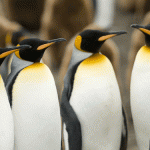
Turing claimed that the interaction of the two morphogens FGF and Shh would combine to create the whole stripe pattern. Image: Shutterstock
British mathematician’s 60-year-old theory of how biological patterns are formed finally proven.
Alan Turing, a British mathematician, biologist and logician regarded as the father of computer science and artificial intelligence, hypothesised in the 1950s that biological patterns such as tiger stripes and leopard spots are formed by the interactions of a pair of morphogens — the signalling molecules that govern tissue development. Fifty-eight years after his death, experimental evidence has confirmed his theory.
The particular pair of morphogens that Turing proposed was an activator and inhibitor. He claimed that the activator would form something like a tiger’s stripe, but the interaction with the inhibitor would shut down its expression, creating a blank space. The process would then reverse, forming the next stripe. The interaction of these two morphogens would combine to create the whole stripe pattern.
Researchers from King’s College, London, were able to validate Turing’s hypothesis by studying the development of the regularly spaced ridges found in the roof of the mouth in mice, and carried experiments on mice embryos, identifying how the pair of morphogens worked together and how they could predict when ridges appear. They were able to pinpoint the specific morphogens responsible for the ridge pattern — FGF (Fibroblast Growth Factor) and Shh (Sonic Hedgehog) — and show how the ridges in the mouth palate are affected in ways predicted by Turing’s equations.
Researcher Dr. Jeremy Green from the Department of Craniofacial Development at King’s Dental Institute said on Science Daily: “Regularly spaced structures, from vertebrae and hair follicles to the stripes on a tiger or zebrafish, are a fundamental motif in biology. There are several theories about how patterns in nature are formed, but until now there was only circumstantial evidence for Turing’s mechanism. Our study provides the first experimental identification of an activator-inhibitor system at work in the generation of stripes — in this case, in the ridges of the mouth palate.”
By proving Turing’s theory, not only does it demonstrate how patterns such as stripes are formed, it also provides confidence that these morphogens can possibly be used in future regenerative medicine to regenerate structure and pattern when differentiating stem cells into other tissues. However, more research needs to be conducted.
The validation of Turing’s theory is a fitting tribute, as June 23 this year marks the mathematician’s centenary.
Source: Science Daily







Thomas Zychowski
July 6, 2012
It is all a mathematical equation in the end.